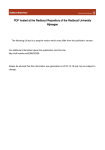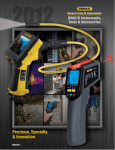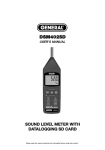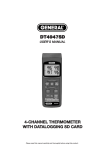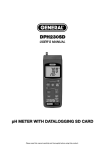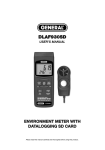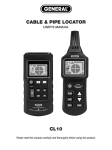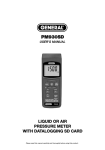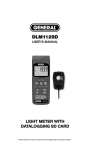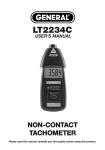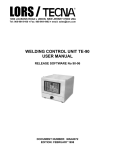Download ManUal - General Tools And Instruments
Transcript
CONTACT TACHOMETER User’s ManUal CT6235B Please read this manual carefully and thoroughly before using this product. TABLE OF CONTENTS Introduction. . . . . . . . . . . . . . . . . . . . . . . . . 3 Key Features . . . . . . . . . . . . . . . . . . . . . . . . 4 Safety Instructions . . . . . . . . . . . . . . . . . . . 4 What’s in the Case . . . . . . . . . . . . . . . . 4 – 5 Product Overview . . . . . . . . . . . . . . . . . . . . 6 Setup Instructions. . . . . . . . . . . . . . . . . . . . 7 Install Batteries . . . . . . . . . . . . . . . . . . . . 7 Operating Instructions . . . . . . . . . . . . 7 – 12 Simulating Speed Measurements . . 7 – 10 Measuring Rotating Speeds . . . . . 10 – 11 Measuring Linear Speeds . . . . . . . 11 – 12 Measuring Surface Dimensions . . . . . . 12 Specifications . . . . . . . . . . . . . . . . . . 13 – 14 Maintenance Tips . . . . . . . . . . . . . . . . . . . 14 Warranty Information . . . . . . . . . . . . 14 – 15 Return For Repair Policy . . . . . . . . . . . . . . 15 2 INTRODUCTION Thank you for purchasing General Tools & Instruments’ CT6235B Contact Tachometer. Please read this user’s manual carefully and thoroughly before using the instrument. The CT6235B is a general-purpose instrument that uses dedicated fittings to measure—on contact—the speed of a motor or generator’s rotating shaft and the linear speed of a moving surface such as a conveyor belt or the circumference of a wheel. The instrument also can be used as a ruler, to measure the dimensions of stationary objects. Measurements are displayed in real time on a 1 in. high backlit liquid-crystal display and stored in memory. Up to 96 measurements of rpm or linear speed can be stored, indexed and recalled, along with the last value, the minimum value and the maximum value of the series. Thanks to its five-digit display, the tachometer can measure rotational speeds from 0 to 20,000 rpm, linear speeds from 5cm/min (2 in./min) to 2km/min (6,562 ft./min), and lengths from 5cm to 10km (2 in. to 6.2 miles). The CT6235B is powered by four “AA” batteries (included) or an optional 6V AC/DC adapter. 3 KEY FEATURES • Uses contact measurement technique and autoranging • Includes fittings for measuring the speed of a rotating shaft and the linear speed of a conveyor • Wide measurement range and high resolution • Backlit 1 in. high display supports work in low light • Stores and indexes up to 96 measurements • Memorizes the last, minimum and maximum values of a series of measurements • Also measures any dimension of a stationary object, in meters • One-handed operation • Auto power off function extends battery life SAFETY INSTRUCTIONS Spinning shafts and fast-moving conveyor belts can be dangerous. When using the tachometer, take care not to let your fingers, hands, hair or clothing make contact with moving parts. WHAT’S IN THE CASE The CT6235B comes fully assembled in a carrying case along with the following accessories (see Figure 1): • Three rubber fittings—called rpm adapters—for making contact with the end of a rotating shaft of a motor or generator. Two have cone-shaped rubber tips that fit into a hol4 lowed (concave) end of a metal shaft; one (B) has a large cone compatible with a 1/2 in. diameter shaft, the other (J) has a smaller cone that fits into shafts 1/4 in. across. The third (K) fitting has its own hollowed end; it is designed to fit over a 1/4 in. diameter shaft with a flat or slightly convex end. • One rubber/plastic fitting (the surface speed wheel A) for (B) making contact with a surface in linear motion. The surface speed wheel has a 1/8 in. slot into which moving 1/2" RUBBER RPM ADAPTER wire, cable or rope fits INSERTED IN BLACK PLASTIC SLEEVE snugly. • Four “AA” batteries • This user’s manual (A) (K) Fig. 1 RPM ADAPTER WITH HOLLOWED END FOR 1/4" DIAMETER SHAFTS WITH FLAT OR CONVEX END SURFACE SPEED WHEEL (J) 1/4" RUBBER RPM ADAPTER 5 PRODUCT OVERVIEW Figure 2 shows all of the controls and indicators and other physical features of the CT6235B. Familiarize yourself with their names and locations before continuing. A. Surface speed wheel 1/2" RPM ADAPTER B. 1/2" rubber rpm adapter SURFACE INSERTED IN BLACK SPEED WHEEL PLASTIC SLEEVE (shown inserted in plastic sleeve) B C. Tachometer shaft A D. Measurement button C (on right side) E. Function switch, labeled “m, m/min, rpm” I F. MEM button D G. Display window E H. Battery compartment F cover (in back) I. Jack for 6-V AC/DC adapter (on left side) G J. 1/4" rubber rpm adapter K. 1/4" rubber rpm adapter with hollowed end H J K Fig. 2. The CT6235B’s controls and indicators and other physical features 6 SETUP INSTRUCTIONS INSTALL BATTERIES To gain access to the battery compartment, slide its cover in the back of the instrument (callout H of Fig. 2) down and away from the unit. Then install four “AA” batteries in the correct orientation, using the polarity marks on the inside of the compartment as a guide. Don’t forget to install the batteries over the ribbon, which makes it easier to remove them later. Replace the battery compartment cover, tucking the end of the ribbon under it. OPERATING INSTRUCTIONS SIMULATING SPEED MEASUREMENTS Before using the CT6235B on actual equipment, General suggests that you familiarize yourself with the way the instrument measures, stores and recalls speeds by spinning the tachometer’s shaft by hand. By simulating readings you can expect to see in practice, you will safely gain expertise that will save you time later. To get started, make sure the black plastic sleeve (see Fig. 1 (B) ) is installed on the tachometer’s shaft (callout C of Fig. 2), with the slot of the sleeve over the shaft’s metal pin. Cradle the tachometer in your right hand. Move the function switch (callout E of Fig. 2) to either the “m/min” or “rpm” position. Then press the Measurement button on the right side of the instrument (callout D of Fig. 2) with your right thumb. Note that this illuminates the display window. The display should show “0”, either with the letters “rpm” directly below it or with the letters “m/min” below it to the left, depending on the position of the function switch. 7 To simulate a speed measurement, keep the tachometer cradled in your right hand and spin its shaft by “flicking” it with the middle two fingers on your left hand while pressing the Measurement button with your right thumb. Note how the display tracks the force of your flicks, and also how the instrument powers off whenever the Measurement button if released (this “dead man switch” feature extends battery life considerably). To simulate storing measurements, keep the Measurement button depressed with your right thumb while you make three simulated speed measurements, as follows: • Flick the shaft with your left index finger once. Store the displayed reading by pressing the MEM button with your left thumb. • Flick the shaft again to make another simulated measurement. Store this reading by pressing the MEM button again. • Flick the shaft a third time and store the third reading as well by pressing the MEM button. After simulating and storing three measurements, release the Measurement button and do not press it again until instructed to. To simulate recalling stored measurements, press the MEM button once and hold it. This illuminates the display, which now shows the highest of the three readings you have just stored. Note that if you continue holding the MEM button, the display alternates between showing the highest value and the letters “UP”, signifying the maximum speed. 8 Also note that releasing the MEM button powers off the display and the instrument. Now press the MEM button twice and hold it. This again illuminates the display, but now it shows the last reading you stored, indicated by and alternating with the letters “LA”. Finally, press the MEM button three times and hold it. This retrieves the slowest of the three speeds you measured and stored. This value is shown alternating with the letters “dn”, signifying the minimum speed. To try out other memory-related features, you can now press the Measurement button on the right side. Now press the MEM button once, twice and three times (holding it in each time) and note from the display that all three of your stored measurements have been erased (indicated by “0.0” readings for UP, dn and LA). You can confirm this by pressing and holding the MEM button until the display begins counting down from 20. When the count reaches 0, the display immediately switches to showing the letters “AN” on the left side and a number (in this case, “0”) on the right. (The letters “AN” are an abbreviation for the Ancient Greek word for “recall.”) To complete this simulation exercise and put your new expertise to the test, make and store a set of five simulated measurements by hand-spinning the tachometer’s shaft and using the MEM button. Then, remembering not to press the Measurement button, press and hold the MEM button as many times as needed to make the display go into countdown mode. 9 Note that because you have stored five measurements, the display will read “AN 5” once the countdown reaches zero. If you release the MEM button and then press and hold it again, the display will first read “1” and then the value of the first of the five measurements you stored. If you release the MEM button and then press and hold it again, the display will then show “2”, followed by the value of your second measurement. Release, press and hold again, and the display will show “3”, followed by the value of your third measurement. By repeating this sequence, you can retrieve up to 96 measurements in the order in which they were stored. Once all of the stored measurements have been displayed, the tachometer will return to the mode in which pressing the MEM button once, twice or three times calls up the minimum, maximum and last values of the set of measurements you have stored. With this simulated experience under your belt, you can now confidently measure the rotational speed of a spinning motor or generator shaft, or the linear speed of virtually any conveyor belt. MEASURING ROTATING SPEEDS To measure the speed of a rotating shaft, first make sure that the black plastic sleeve (see Fig. 1 (B)) is installed on the tachometer’s shaft (callout C of Fig. 2), with the slot of the sleeve over the shaft’s metal pin. To measure the speed of a motor’s or generator’s shaft with a hollowed (concave) end, determine which of the two supplied cone-tipped rpm adapters (see Fig. 1) fits more snugly in the hollow. Push the flat end of that adapter into the end of the plastic sleeve. Then slide the function switch on the front panel (callout E of Fig.2) to the “rpm” position. 10 Cradle the tachometer in your right hand. While pressing the Measurement button on the right side of the instrument with your right thumb, gently push the cone-tipped end of the rpm adapter into the cavity at the end of the spinning motor or generator shaft whose speed you wish to measure. Take care to keep the two shafts aligned. When the displayed reading has stabilized, and while keeping the Measurement button depressed with your right thumb, press the MEM button on the front panel with your left thumb to store the measurement. Make and store as many measurements as you wish, using the lessons learned during the simulation exercise. If the end of the shaft whose speed you want to measure is flat or slightly convex and has a diameter of 0.25 in, locate the rubber fitting with a 1/4 in. diameter hole at its wider end. Insert the narrow end of this fitting into the black plastic sleeve on the instrument’s shaft. Make sure the function switch is set to “rpm”. Then, while cradling the tachometer in your right hand, carefully push the other end of the fitting around the end of the motor or generator shaft. Take care to line up the shafts of the equipment and the tachometer. Using the Measurement and MEM buttons, make and store as many readings of rotational speed as you wish. MEASURING LINEAR SPEEDS To measure the linear speed of a conveyor belt, remove the plastic sleeve and any rubber fitting inserted in it from the tachometer’s metal shaft. Locate the surface speed wheel and install it on the tachometer’s shaft, sliding the slot in the wheel’s stem over the tachometer shaft’s metal pin. 11 Set the function switch to the “m/min” position. Then, cradling the tachometer in your right hand, press the edge of the surface wheel against the moving object whose linear speed you wish to measure. Note that the circumference of the wheel has a 1/8-in.-wide slot into which wire, cable or rope of that diameter fits snugly. Taking care to keep the tachometer perpendicular to the moving conveyor, use the function and MEM buttons to make and store as many measurements of linear speed as you wish. Linear speed measurements of moving objects obtained by placing them in contact with the outer diameter of the surface speed measurements are accurate as displayed. However, to compensate for the smaller inner diameter of the wheel within its slot, measurements made by placing wire, cable or rope within the slot should be multiplied by 0.9. MEASURING SURFACE DIMENSIONS The CT6235B can also serve as a metric ruler. To operate it in that mode, move the function switch to the “m” position and install the surface speed wheel directly onto the instrument’s metal shaft. Cradling the tachometer in your right hand and pressing and holding the Measurement button, roll the wheel across the length, width or depth of the object you wish to measure. The displayed value represents the dimension measured, in meters. Measurements made in this mode of operation cannot be stored, and disappear from the display when the Measurement button is released. 12 SPECIFICATIONS Measurement ranges Rotational speeds from 0 to 20,000 rpm; linear speeds from 5cm/min (2 in./min) to 2km/min (6,562 ft/min); lengths from 5cm to 10km (2 in. to 6.2 miles) Measurement accuracy ±0.05% of reading plus one digit Resolutions 0.1 rpm for rpm measurements to 999 rpm, 1 rpm at higher speeds; 0.01m/min for linear speeds up to 99.99 m/min, 0.1m/min at higher speeds; 0.02m over full length measurement range Sampling time 0.8 seconds at speeds over 60 rpm Storage capacity 96 measurements Recallable measurements Maximum, minimum, last Microcontroller Single custom chip Time base Quartz crystal Display type 5-digit yellow-green backlit liquid crystal Display dimensions 1.0625 in. high x 1.8725 in. wide (27 x 47.6mm) Instrument dimensions 8.27 x 2.91 x 1.46 in. (210×74×37mm) Instrument weight 0.62 lb. (280g), including batteries 13 Power source Four “AA” batteries or optional 6V AC/DC converter Current consumption 65mA Operating temperature range 32° to 122°F (0° to 50°C) @ up to 80% relative humidity MAINTENANCE TIPS The CT6235B requires no regular maintenance other than light cleaning of the housing and display with a soft, dry cloth. When the text “LO” appears on the display, it’s time to change the CT6235B’s four “AA” batteries because their total potential has fallen below 4.5 volts. To do so, follow the Setup Instructions on p. 7. Remove the batteries whenever the instrument is expected to sit idle for an extended period of time (six months or more). WARRANTY INFORMATION General Tools & Instruments’ (General’s) CT6235B Contact Tachometer is warranted to the original purchaser to be free from defects in material and workmanship for a period of one year. Subject to certain restrictions, General will repair or replace this instrument if, after examination, the company determines it to be defective in material or workmanship. This warranty does not apply to damages that General determines to be from an attempted repair by non-authorized personnel or misuse, alterations, normal wear and tear, or accidental damage. The defective unit must be returned to 14 General Tools & Instruments or to a General-authorized service center, freight prepaid and insured. Acceptance of the exclusive repair and replacement remedies described herein is a condition of the contract for purchase of this product. In no event shall General be liable for any incidental, special, consequential or punitive damages, or for any cost, attorneys’ fees, expenses, or losses alleged to be a consequence of any damage due to failure of, or defect in this product including, but not limited to, any claims for loss of profits. RETURN FOR REPAIR POLICY Every effort has been made to provide you with a reliable product of superior quality. However, in the event your instrument requires repair, please contact our Customer Service to obtain an RGA (Return Goods Authorization) number before forwarding the unit via prepaid freight to the attention of our Service Center at this address: General Tools & Instruments 80 White Street New York, NY 10013 212-431-6100 Remember to include a copy of your proof of purchase, your return address, and your phone number and/or e-mail address. 15 GENERAL TOOLS & INSTRUMENTS 80 White Street New York, NY 10013-3567 PHONE (212) 431-6100 FAX (212) 431-6499 TOLL FREE (800) 697-8665 e-mail: [email protected] www.generaltools.com CT6235B User’s Manual Specifications subject to change without notice ©2011 GENERAL TOOLS & INSTRUMENTS NOTICE - WE ARE NOT RESPONSIBLE FOR TYPOGRAPHICAL ERRORS. MAN#CT6235B 2/10/11
















